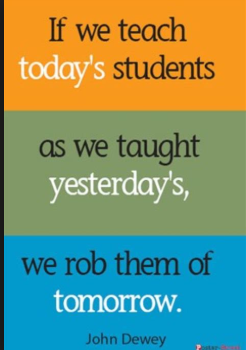What is Personalized Learning?
Personalized Learning is a method of teaching which prioritizes student choice and multiple pathways to develop skills in a student. The idea of personalized learning is to create “a school and classroom culture that engages students to do their best work.” (Blankstein, 2015). Personalized learning recognizes that not every student can learn through a lecture and test model of instruction. It allows flexibility in developing concepts and critical thinking skills within the context of state and national standards. This sounds similar to many classes throughout the country. Project based learning, online course content, choice projects all lend themselves naturally to a personalized learning model.
Another critical piece of personalized learning is feedback. Students and teachers are required to make revisions to work and lesson designs based on the outcomes of student progress. Blankstien and Noguera (2015) describe three criteria for teacher feedback: the feedback must be student friendly, written in language geared towards the audience of the students within the classroom; it must be provided regularly; finally, it must be action-oriented focusing specifically on how to make improvements rather than focusing on what is incorrect.
A final feature of personalized learning is that it requires students to develop an interest in what they are learning. Students choose topics that they care deeply about and work to expand skills around those topics of interest.
What is Adaptive Learning?
Adaptive learning utilizes the idea of individualized learning for students but relies heavily on technology for the customization of student learning. Data is the hallmark of Adaptive Learning with assessments placing students on individualized modules and tracks, every activity is evaluated by computer software and next steps are tailored to projected outcomes. Cheryl Lemke (2013) describes adaptive learning as digital learning that “immerses students in modular learning environments where every decision a student makes is captured, considered in the context of sound learning theory and then used to guide student’s learning experiences, to adjust the student’s path and pace within and between lessons, and to provide formative and summative data to the student’s teacher.” This model provides live modifications for students and allows classroom teachers to monitor not only student progress but actively view and customize lessons that work for each individual student.
Programming within these educational softwares collect data on all of their users creating digital footprints connecting what students struggle with to what strategies lead to success. Seth Stephens-Davidowitz in his novel Everybody Lies Big Data, New Data and What the Internet Can Tell Us About Who We Really Are describes this kind of customization as finding a user’s doppelganger. In his novel he describes data tracking to find user likes and dislikes primarily as it relates to marketing. However, educational programs act under this same guiding principle of finding a similar student pathways and connecting students to a pathway that matches their similar learning style.
Teachers can use this information in a variety of ways. One method would be using a flipped classroom model. This would be where students learn key concepts online then come to class for project based learning or reteaching based on computer feedback. Teachers have access to the information collected by the computers and then can tailor their lessons to the needs of the students. This allows for a distancing of teaching to the middle by allowing teachers to know what students need to work on and what they need to be challenged on.
Can These Two Concepts Work Together?
At first glance, personalized learning and adaptive learning seem very similar. Both stress the need for individualized learning and lessons for students. Both move away from traditional teach and quiz methods of classroom lessons. Both state the importance of feedback for students as well as student centered activities. However, the main difference in these methods is in the delivery of instruction. Personalized learning focuses on interdisciplinary student centered lessons. These lessons are based on what students are interested in and target high interest topics which connect to state and national grade level standards. Adaptive learning meets students where they are (whether that be above or below grade level) and fill in the gaps or challenge the advanced skills students need to work on. Adaptive learning takes instant data of student progress and creates customized tracks with lessons and resources available that the program believes will be most beneficial to student growth. On the other hand personalized learning relies heavily on the student and teacher to develop resources and project ideas that will be engaging and fulfilling. Adaptive learning focuses less on what the state and national standards are and stresses the pacing of learning needs to meet the individual not the other way around.
So, can these concepts work together to create an engaging and 21st century classroom?
Absolutely!
Adaptive learning should not take the place of a traditional classroom but be another tool in a teacher’s toolbox to create engaging and meaningful lessons. Flipped classrooms can utilize both adaptive and personalized learning. A student can gain foundational knowledge at home and then come to class and practice skills through projects and choice activities. Adaptive learning programs can supplement the state and national standards and help raise student interest in topics. The use of gaming, videos, personalized feedback and instantaneous results can lead to students being invested in what they are learning and more invested in what they are learning.
Concerns With Adaptive Learning
One major concern with adaptive learning is the issue of data collection. While it is amazing to create student profiles complete with what resources, lessons and modifications have been most successful for different types of learners educators should be cautious in what information is being collected stored and used in the future.
Another concern is the risk of over utilizing technology at the expense of individualized face to face teaching. Teachers should not change their classroom models to only utilizing adaptive learning with students in a silent circle on laptops, tablets and chromebooks. There is an appropriate balance necessary between screen time and face to face lessons. Not only this but online classrooms and programs do not work for every student. It is important to recognize that student performance with one tool is not indicative of their academic abilities.
Additionally, one major drawback of adaptive learning is the reliance on technology. Many students do not have reliable access to technology or internet which may make utilizing these programs outside of the classroom difficult to impossible. Additionally, many schools struggle with old and out of date infrastructure such as bandwidth limitations or old technology which limits the ability to effectively utilize adaptive learning.
A final, major, concern is that of student engagement. A good teacher knows when students are disengaged and has strategies on hand to negate this. A computer program may be able to recognize that a student is disengaged but, depending on what is causing the disinterest, may not be able to help the student get back on track. Furthermore, as with any technology, there is the risk of students not only being disengaged but actively off task. Having different web browsers up such as google hangouts or youtube while working on the computers is a problem within the education system. Students need to be able to be engaged without the distractions that come along with the benefits of technology.
Final Thoughts
If I had unlimited resources and were a policy maker I would try to find a way to evaluate different adaptive learning programs on the market. One fear I have within education is the commercialization of our students and education system. Companies actively market educational products to schools throughout the country and the effectiveness of these tools is mixed. While there are amazing engaging and beneficial programs there are also those put together hastily to try and maximize profits. A panel similar to the National Literacy Panel could examine popular adaptive learning programs and evaluate which are not only research backed but proven effective for students. I would like to see further use of adaptive learning and personalized learning in schools. Overall, teachers need training in these techniques and need to be able to see what these lessons can do for student success. Teachers should participate in lesson studies observing successful classroom models for ideas of how to implement these strategies in their own teaching.
What do you see as the greatest benefit of personalized and adaptive learning? What are some drawbacks or concerns that you still have?
References
Blankstein, A. M., & Noguera, P. (Eds.). (2015). Excellence Through Equity: Five Principles of Courageous Leadership to Guide Achievement for Every Student. Corwin Press.
Educause. (2017). 7 Things you should know about… Adaptive learning. Retrieved from: https://library.educause.edu/~/media/files/library/2017/1/eli7140.pdf.
Educause. (2017). 7 Things you should know about… Personalized learning. Retrieved from: https://library.educause.edu/~/media/files/library/2015/9/eli7124-pdf.pdf.
Lemke, C. (2013) Intelligent adaptive learning: an essential element of 21st century teaching and learning. Dreambox Learning. Retrieved from: http://www-static.dreambox.com/wp-content/uploads/2013/03/white-paper-intelligent-adaptive-learning-21st-century-teaching-and-learning.pdf.
Stephens-Davidowitz, S. (2017). Everybody Lies Big Data, New Data and What the Internet Can Tell Us About Who We Really Are. New York, New York: Harper Collins.

